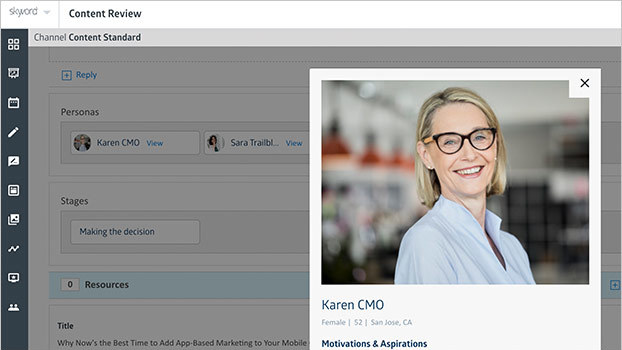Content Strategy
Speaking with a Stronger Brand Voice: How to Change the Tone of Your Content
By Celina Durgin on August 21, 2018
"Watch your tone!"
Many of us associate being told to change our tone of voice with childhood reprimands for speaking disrespectfully to our parents. Our actual words might have been innocuous enough: "OK," "Yes, Mom," "One minute," "Coming!" But when saying these words aloud, we soon learned that relatively minor changes in volume and inflection could determine whether we had an easy interaction or received stern rebuke.
For content marketers, the tone of your brand voice often involves more than vocal inflections (It typically doesn't involve spoken words at all). A brand's tone includes various aspects of your strategy, such as your target audience or content personas, design features like color and font, and the small word or phrase choices that can shape readers' impression of your brand.
The way you project your voice, whether it be edgy, or comforting, or authoritative, can often become your brand's defining feature. So if you fear you've been creating tone-deaf content that doesn't accurately express your message, here's how you can successfully implement a brand tone shift.
It's How You Say It
In a two-part study, Nielsen Norman Group found measurable effects of word choice on audience perceptions of an organization's "friendliness, trustworthiness, and reliability." Elsewhere, Nielsen writer Kate Moran showed how easily tone can be altered-in this case, from straightforward or serious to playful-through the example of a typical 404 error page. By taking an enthusiastic approach to a rather matter-of-fact sentiment, "We apologize, but we are experiencing a problem" can become "Oops! We're sorry, but we're experiencing a problem on our end." The meaning of the message remains the same, but adding a few words transforms this page from straightforward to friendly and fun.
Your marketing team may reach a point when you should consider shifting the tone of your brand voice. Doing so demands not only an assessment of your current strategy, but also a plan for transitioning smoothly to the new one, so that your brand's essential identity persists through the change, and your audience and contributors don't get confused about who it is that's speaking to them.
Why Change Your Brand's Tone of Voice?
Perhaps you've realized that your content is a bit too preachy, too serious, or too lighthearted to reach your target audience. Maybe your customer base is undergoing a generational hand off from baby boomers and Generation X to millennials and Generation Z. According to Skyword editorial manager, Jake Roundy, the reason to alter the tone of your brand voice may simply depend on "what's sticking and what's not."
How do you tell what's connecting with audiences? Metrics are a good place to start. If the numbers reveal a pattern, "You need to ask why the less-successful content isn't working," notes Roundy. "Always be evolving with the audience, learning how to better relate to them."
Let's review the example of, Tektonika-a B2B-tech publication on a mission to help people navigate the cutting edge of innovation. Produced by Hewlett-Packard, Tektonika also sought to interest paper-shy millennials in HP printers. With Tektonika, HP created an unusually funny tech blog with a witty tone, pop-culture references, and a colorful yet minimalist modern design.
However, beyond reaching millenials in the workplace, the Tektonika team needed to reach an audience of seasoned "IT decision-makers."' These IT professionals were part of an older demographic that already had lots of experience with printerhardware. Thus, the need to also create content that was more no-nonsense and offered tactical advice on improving productivity at work.
Image attribution: Tektonika Mag
Today, a glance at Tektonika reveals a content strategy that aptly speaks to two distinct audiences-the millennial IT decision-maker and the seasoned IT decision-maker. The former may be excited by creating a more productive work environment through cool, new technology, but might struggle with the challenges of making decisions within and navigating a complex organization. More experienced decision-makers are also excited about technology but more cautious and methodical in making and executing business decisions.
While balancing the nuances of speaking to different people, Tektonica succeeds because of its focus on incorporating the needs of both in each piece of content published. This smart content strategy is married to a website with sleek style that incorporates sophisticated imagery (to capture the younger working audience) with a direct, logical writing style (that speaks to seasoned professional).
How to Change Your Tone
After you've learned that your content needs to evolve with your audience, there are several steps required to manage a tone shift. You should analyze why your current strategy is no longer reaching readers before you begin making changes. You'll also need to get your contributors on board with the new strategy. Finally, you'll need to pull off a graceful transition away from the old tone without giving your audience whiplash.
Here are the three main steps entailed in changing your brand tone of voice:
1. Evaluate Your Present Tone
When attempting to discover what parts of your current brand voice are falling flat with users, it's helpful to start with questions like these:
- How can you adjust your content persona(s)?
- Are there words you want to add or remove from the vocabulary of your content?
- Are there small, easy ways to inject some personality into something you've ignored or left standard (like 404 error pages, design details, or calls to action)?
- Is your keyword strategy distorting your tone?
- Should you use humor, and if so, what kind of humor?
Once you've identified a few key weakness areas, you can begin plotting the direction your tone should be moving towards in the future.
2. Communicate with Freelance Content Contributors
The success of executing a tone shift depends crucially on how well it is relayed to the people who actually put it into practice: your contributors.
For Roundy, editorial guidelines were essential when managing a client's tone shift. When a change requires major guideline updates, Roundy will send monthly contributor newsletters that parcel a standard 30-page guideline document into digestible points. Next, he leads a workshop providing an overview of the new direction and records the workshop for freelancers who can't attend the Google Hangouts session.
Using Skyword360 content marketing software, Roundy has the added benefit of codifying content guidelines and personas. The software makes this information accessible to freelancers as they create content.

Image attribution: Skyword
In general, the editorial team responsible for your content will play a large part in evaluating, updating, and conveying the guidelines to your content contributors and training them for any transition. The goal is to paint a clear picture of your overarching vision as well as to guide the contributors through its practical reality of editorial minutia. It can even be a huge asset for your marketing team to provide your contributors with insights into your brand personas, so they understand exactly what audience they're speaking to in their content.
3. Maintain Continuity
Implementing a new tone across all of your marketing channels from your main blog to social media is a slow and steady process. If every piece of content uploaded to your site went from sleek and serious one day to playful and colorful the next, that would confuse the heck out of your audience!
Of course, most shifts are much subtler than that, or, if dramatic, evolve gradually over time. But creating continuity with previous content is always challenging, especially if your organization has been publishing content for a while. If you do have a substantial archive, you may need to conduct an audit to identify which articles to delete, which to repurpose, and which to redirect to more recent articles on the same topic. Changes to tone, including website design, can be introduced over weeks or months-you don't need to implement everything at once.
That said, consider whether there is an appropriate way or time to explicitly communicate this shift to your audience. More dramatic changes in content style may require an announcement to your current base, prepping them for the arrival of your updated branding with an introductory blog or Twitter Q&A. In most cases, this warning won't be necessary-and may even be disadvantageous-but certain reasons for making the change, such as the launching of a new product line, may also prompt this forthrightness.
Finally, think about the company's mission and values in the context of creating continuity. Introducing, for example, a more conversational tone doesn't entail sacrificing your brand's value of trust or your organization's mission of challenging the status quo in the way that suddenly reversing your ethical stance on envriomental production would, for example.
Becoming More Like Yourself
Ultimately, shifting your brand tone of voice will serve to enhance your organization's identity, not to change it completely. Evolving with your audience enables you to communicate more clearly that you understand them and their needs. Assessing your current tone and guidelines can help you in turn better understand how to position your brand in the marketplace. And collaborating with your team to craft and convey these updates to your contributors will help everyone see your vision.
For more stories like this, subscribe to the Content Standard newsletter.
Featured image attribution: Gage Walker


